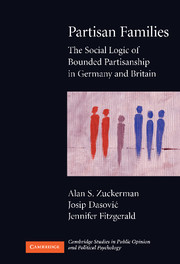Book contents
- Frontmatter
- Contents
- List of Figures and Tables
- Acknowledgments
- Preface: The Theoretical Approach, the Question, and the Data
- 1 The Social Logic of Partisanship: A Theoretical Excursion
- 2 Bounded Partisanship in Germany and Britain
- 3 A Multivariate Analysis of Partisan Support, Preference, and Constancy
- 4 Bounded Partisanship in Intimate Social Units: Husbands, Wives, and Domestic Partners
- 5 Bounded Partisanship in Intimate Social Units: Parents and Children
- 6 Partisan Constancy and Partisan Families: Turnout and Vote Choice in Recent British Elections
- Conclusion: Family Ties, Bounded Partisanship, and Party Politics in Established Democracies
- Appendix
- References
- Index
- Books in the Series
3 - A Multivariate Analysis of Partisan Support, Preference, and Constancy
Published online by Cambridge University Press: 05 June 2012
- Frontmatter
- Contents
- List of Figures and Tables
- Acknowledgments
- Preface: The Theoretical Approach, the Question, and the Data
- 1 The Social Logic of Partisanship: A Theoretical Excursion
- 2 Bounded Partisanship in Germany and Britain
- 3 A Multivariate Analysis of Partisan Support, Preference, and Constancy
- 4 Bounded Partisanship in Intimate Social Units: Husbands, Wives, and Domestic Partners
- 5 Bounded Partisanship in Intimate Social Units: Parents and Children
- 6 Partisan Constancy and Partisan Families: Turnout and Vote Choice in Recent British Elections
- Conclusion: Family Ties, Bounded Partisanship, and Party Politics in Established Democracies
- Appendix
- References
- Index
- Books in the Series
Summary
Partisanship in Germany and Britain reflects the analytical ties among religion, social class, and party that have characterized European politics for decades and that persist, even as indications of “individualized politics” appear. More fundamentally, however, our analyses underline the importance of immediate social and political networks as contexts for decisions about the political parties. Individuals choose political parties, at any point in time and over time, by taking into account the perceptions, values, actions, and cues of persons in their social networks. The stronger and the more frequent the social tie, the more powerful is the influence; families and households are especially important. There is a social logic to bounded partisanship.
MODELING PARTISANSHIP
In this chapter, we begin the analysis of partisan support, preference (choice), and constancy. Note that no one can select or choose a party without first claiming to support a party. Over time, the rate of picking a party requires naming or selecting it at least once. The initial survey question implies a simple answer: to support or not to support a party. In Germany and Britain, the second choice usually means selecting one of the two dominant parties. We model each as a bifurcated decision: to support or not to support a party and to prefer or not Party A/B.
Information
- Type
- Chapter
- Information
- Partisan FamiliesThe Social Logic of Bounded Partisanship in Germany and Britain, pp. 47 - 70Publisher: Cambridge University PressPrint publication year: 2007
